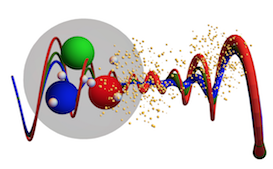Speaker
Description
In this contribution, we present possible new advantages of observing double parton
scattering (DPS) processes initiated by photon-proton interactions. The observation of
DPS processes could lead to access fundamental information on double parton distribution
functions (dPDFs) of the protons [3]. These new quantities, appearing in the DPS cross
section, represent a novel and promising tool to access the 3D partonic structure of the
proton. In fact, dPDFs encode double parton correlations in hadrons which cannot be
accessed through, e.g., GPDs. Up to date, however, dPDFs are almost unknown and, in
particular, their dependence on the transverse distance of partons. However, as proved
in Refs. [1, 2] the information on the partonic proton structure cannot be extracted from
proton-proton collisions data. Therefore, in Ref. [3] we proposed the possibility to observe
DPS in processes initiated by quasireal photons. At such low virtualities, the photon will
fluctuate hadronically and/or electromagnetically in a q − q̄ pair which then initiates a
double parton scattering with the proton. The key idea is that the photon transverse size
could be almost controlled by measuring the virtuality and, in turn, the interaction rate in
the which encodes information on the transverse proton structure. We estimated the DPS
cross section for the four jets production in the HERA kinematics, and concluded that
DPS processes in photoproduction gives a significant fraction of the four jet production
cross sections. Recently, we started the study of the different mechanisms contributing to
photoproduction of quarkonium pairs in NRQCD at the EIC, namely via unresolved and
resolved photons. In the latter case, we study the relevance of double parton scatterings
along the lines of Refs. [3, 4, 5, 6, 7, 8, 9]. Like for the hadroproduction case, quarkonium-
pair photoproduction probes, in different kinematical domains, very different interesting
phenomena which will be made accessible at the future US EIC.
References
[1] M. Rinaldi and F. A. Ceccopieri, JHEP 1909, 097 (2019)
[2] M. Rinaldi and F. A. Ceccopieri, Phys. Rev. D 97, no. 7, 071501 (2018)
[3] F. A. Ceccopieri and M. Rinaldi, Phys. Rev. D 105 (2022) no.1, L011501
[4] J. P. Lansberg, H. S. Shao, N. Yamanaka, Y. J. Zhang and C. Noûs, Phys. Lett. B
807 (2020), 135559
[5] J. P. Lansberg, Phys. Rept. 889 (2020), 1-106 [arXiv:1903.09185 [hep-ph]].
[6] J. P. Lansberg, H. S. Shao, N. Yamanaka and Y. J. Zhang, Eur. Phys. J. C 79 (2019)
no.12, 1006 [arXiv:1906.10049 [hep-ph]].
[7] H. S. Shao and Y. J. Zhang, Phys. Rev. Lett. 117 (2016) no.6, 062001
[8] J. P. Lansberg and H. S. Shao, Nucl. Phys. B 900 (2015), 273-294
[9] J. P. Lansberg and H. S. Shao,
doi:10.1016/j.physletb.2015.10.083

